
Highest-paid jobs in construction
The U.S. has the largest construction market globally. Projected residential growth has the occupational outlook for construction industry laborers moving 5% faster than other occupation averages projected for 2029, with laborers in the market thriving off jobs that pay well for hard physical labor. Construction industry laborers must work in extreme weather at sometimes daring heights to erect residential and commercial properties under strict state and federal guidelines.
However, the hard physical labor and high-risk of injury pay off, according to the U.S. Bureau of Labor Statistics (BLS) reporting the industries 2017 median annual average of $45,820 trumped all other industry yearly averages of $37,690. Stacker compiled a list of the highest and lowest paying jobs in construction using data from the BLS. Jobs listed as "Construction and Extraction Occupations" were considered, while any job title with "all other" was excluded. Jobs are ranked by annual mean wage as of May 2019, according to data released in 2020.
The progressive industry, made up of "jack of all trades" laborers, has dozens of specialized professions from paperhangers to elevator installers. A majority of entry-level construction jobs do not require formal education; instead, they offer apprenticeships and on-the-job training to educate future employees. Good health and physical strength is an absolute mandate for all construction jobs, making the industry popular among young men and middle-aged men.
Nearly all construction jobs require strong communication and problem-solving know-how, as well as keen mathematics and engineering skills. Many of the highest-paid construction jobs entail travel and schedule flexibility due to project location and mandated deadlines. Yet the growing industry and high-paying jobs make the required distance and time for some projects well worth the price.
Along with each slide, the annual mean wage and total employment in that field are included, as well as some details about what it takes to become one, and what the prospects for the future look like.
Keep reading to find out more about the highest-paid construction jobs in the U.S.

#55. Helpers - painters, paperhangers, plasterers, and stucco masons
- Annual mean wage: $32,930
- Employment: 10,850
Painters, paperhangers (who fill cracks and splits in walls and coverings), plasterers, and stucco masons (who apply cement and plaster to surfaces), cannot be afraid of heights and must be able to stand for long periods. Plasterers and stucco masons can make up to around $52,820 annually when employed by building finishing contractors specifically in the government sector, minus hospitals and schools.

#54. Helpers - roofers
- Annual mean wage: $33,350
- Employment: 8,960
Even as one of the lowest of the highest-paying construction jobs, the roofing trade brings in a stable annual salary in the mid-$30,000 range, with California roofers able to earn up to 24.6% above the U.S. average at $54,035 a year in San Francisco. There is no formal education required to become a roofer, but some union and contractor association apprenticeships are available for on-the-job training.

#53. Helpers - pipelayers, plumbers, pipefitters, and steamfitters
- Annual mean wage: $33,750
- Employment: 58,400
Assistant pipelayers, plumbers, pipefitters, and steamfitters perform rough-ins that entail measuring, cutting, and assembling pipelines behind walls and under floors. They also work on water heater and toilet installation, and repair and fix broken and leaky pipes. The job, which requires no formal education, entails excellent hand-eye coordination, long-term steadiness, and problem-solving.

#52. Helpers - carpenters
- Annual mean wage: $33,830
- Employment: 32,920
Considered one of the most versatile jobs in the construction industry, a carpenter helper performs many types of tasks—from installing cabinets to rough carpentry—which entail framing homes and other supporting structures. Carpenters must be good at math and geometry to measure space and size and be physically fit to carry heavy wood and construction materials throughout the day.

#51. Helpers - electricians
- Annual mean wage: $34,300
- Employment: 79,260
An electrician assistant, who is often required to work on-call, 24/7, must have a high school diploma and certificate from a technical school certifying their skills and knowledge. Apprenticeships are also available for assisting electricians, who must install, maintain, and repair wiring, lighting, and heating systems through residential and commercial buildings by following technical diagrams and blueprints.
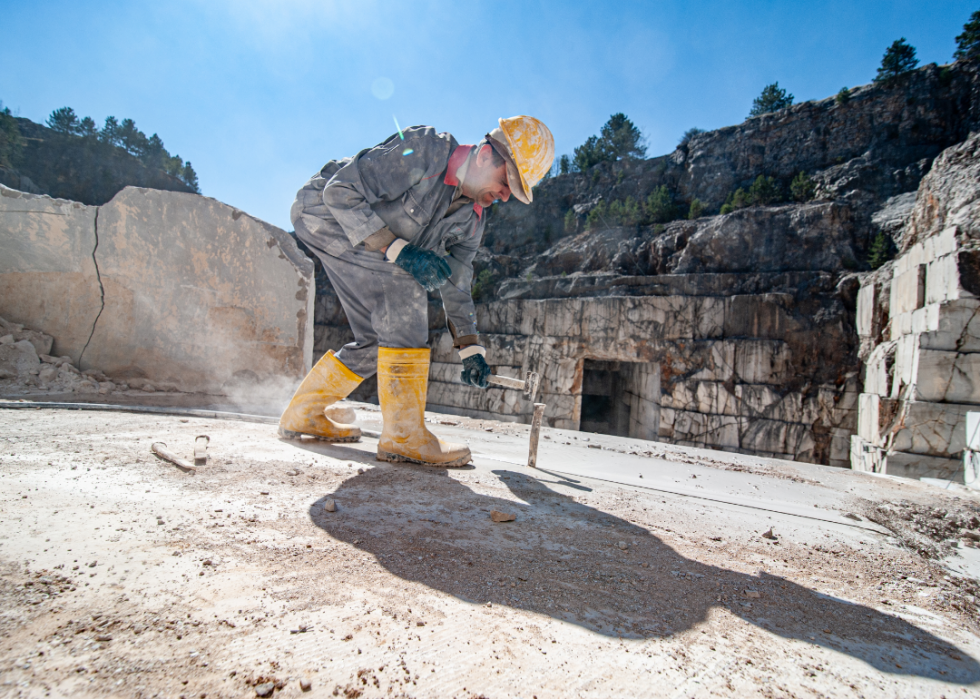
#50. Rock splitters, quarry
- Annual mean wage: $37,390
- Employment: 5,080
Rock splitter and quarry tradespeople must handle heavy machinery, including jackhammers and chop saws to separate stone from quarry masses. Cutting and splitting stone, sometimes in extreme hot and cold temperatures, requires body trunk strength, hand-arm steadiness, and machine control precision, but does not require any formal education.

#49. Helpers - extraction workers
- Annual mean wage: $38,390
- Employment: 16,700
Extraction workers include oil rig crew members, miners, and any other laborer who removes material from the ground or ocean. While extraction workers for oil rigs monitor fuel flow and adjust drilling arms, laborers in the mining industry must monitor the tunnel's physics to measure and drill without causing a fatal collapse correctly. Blowing holes in the ground and underwater depths requires using dangerous equipment.

#48. Helpers - brickmasons, blockmasons, stonemasons, and tile and marble setters
- Annual mean wage: $38,440
- Employment: 23,480
Brick, block, stonemasons, and tile and marble setters stir materials including mortar, grout, and plaster to lay residential and commercial foundations. Helpers must have math and engineering knowledge to efficiently size and cut materials while also having physical strength, endurance, and steady and strong hands.

#47. Fence erectors
- Annual mean wage: $38,600
- Employment: 25,900
The job-identifying title is just as it states, with fence erectors efficiently installing wire and chain link by locating underground power and water lines, measuring areas, aligning posts and structural components, and digging and setting materials in-ground or on a foundation. A high school diploma is all these tradesmen require, trunk and static strength, and firm arm-hand control.
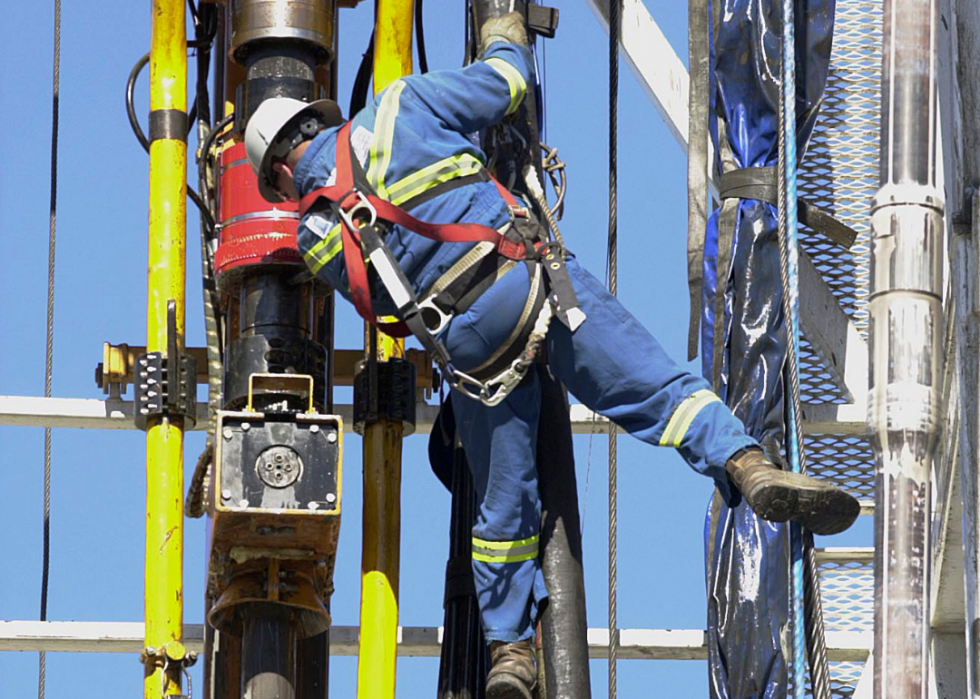
#46. Roustabouts, oil and gas
- Annual mean wage: $41,280
- Employment: 58,930
Roustabouts, and oil and gas drillers require strong physical endurance due to the 12-hour shifts required by the tradesmen who work on fuel rigs. Entry-level roustabouts do not require formal education training for oil and gas; however, natural gas drilling programs and certifications are offered at two-year colleges and vocational schools.

#45. Construction laborers
- Annual mean wage: $41,730
- Employment: 1,020,350
Construction laborers' job tasks vary from cleaning up job sites to running equipment and are critical to highway and building development and environmental remediation. A construction laborer must hold a high school diploma. The entry-level profession is a stepping stone on the career industry ladder, with many laborers moving onto more specialized and higher-paying construction jobs.

#44. Floor sanders and finishers
- Annual mean wage: $42,300
- Employment: 4,940
Surfacing new wood and restoring old lumber is all in a day’s work for floor sanders and finishers. The tradesmen must be able to efficiently operate orbital buffers and sanders to remove glue and nails. Floor finishers and sanders, who often begin under union and construction business apprenticeships, should have strong mechanical drawing and math skills.

#43. Highway maintenance workers
- Annual mean wage: $42,410
- Employment: 150,860
Most roads, highways, and runway maintenance jobs, which require patching cracked concrete, replacing mile markers and guard rails, and plowing snow, are in the federal, state, and local government sectors, with California capping all states for most employment per thousand jobs. The only requirement for the position is a high school diploma.
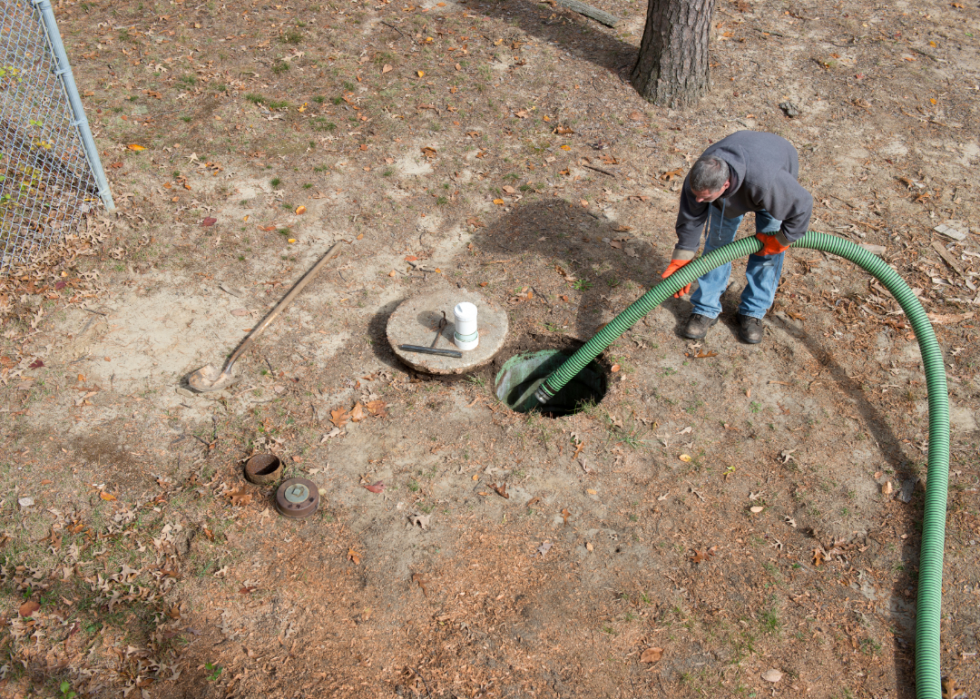
#42. Septic tank servicers and sewer pipe cleaners
- Annual mean wage: $42,760
- Employment: 29,750
Septic tank servicers and sewer pipe cleaners must have manual dexterity and multi-limb coordination while also possessing strong operation monitoring and control skills. While these tradesmen, who must work closely with supervisors, service and clean septic tanks and sewer pipes, they also inspect utility holes, measure excavation sites, and install and remove equipment.
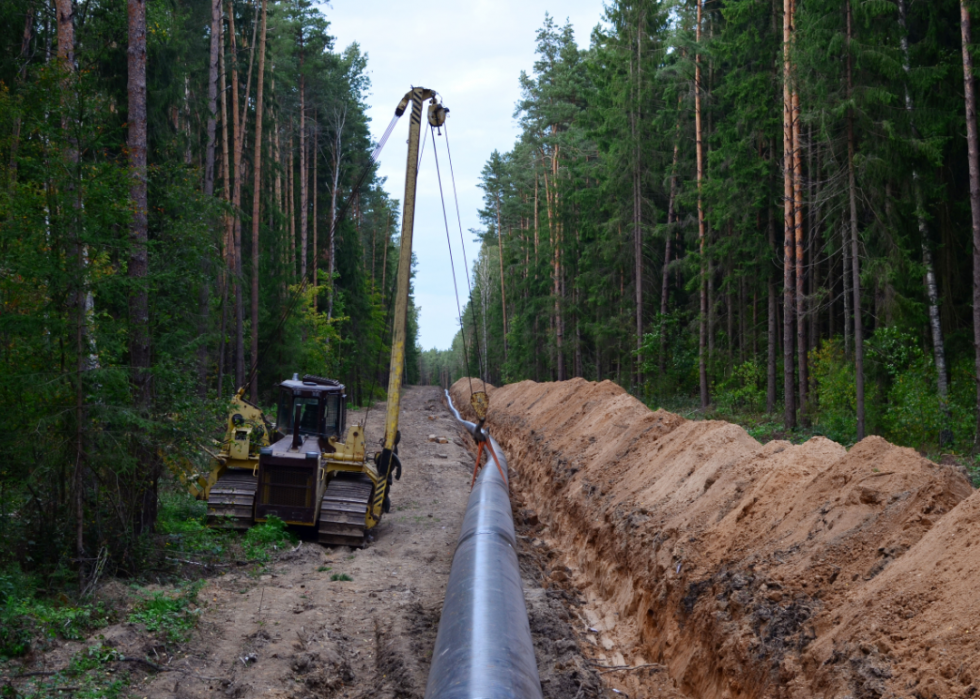
#41. Pipelayers
- Annual mean wage: $43,600
- Employment: 36,270
Full-time pipelayers must have a high school diploma and prior work-related experience. Grading trenches and ditches and sealing joints are some of the daily tasks performed by pipelayers, who must have excellent vision and arm-hand steadiness, as well as critical thinking and coordination skills.

#40. Paperhangers
- Annual mean wage: $44,470
- Employment: 3,380
Surfacing walls and ceilings with decorative and protective material, including wallpaper, is the paperhanger's primary duty. The tradesmen must have strong customer service skills and attention to detail, use paintbrushes, rollers, and knives to apply and remove materials. Not having a fear of heights is a requirement for paperhangers, who also apply billboard signage from scaffolds.

#39. Paving, surfacing, and tamping equipment operators
- Annual mean wage: $44,630
- Employment: 45,770
These specific equipment operators pave, surface, and tamp asphalt, concrete, and other materials for roadbeds, parking lots, airport runways, and taxiways. Along with operating road-surfacing equipment, these laborers also load materials, monitor construction operations, direct vehicle traffic, and spread sand and dirt. Some U.S. states require an operating license to practice the profession.

#38. Painters, construction and maintenance
- Annual mean wage: $44,640
- Employment: 232,760
Arm-hand steadiness, trunk strength, and near vision are all required for painters and construction maintenance laborers. Daily tasks include following work orders, covering materials, applying primers and sealers, smoothing surfaces, and filling holes. While a little more than half of painters and construction maintenance workers have a high school diploma, 30% do not.

#37. Insulation workers, floor, ceiling, and wall
- Annual mean wage: $45,100
- Employment: 33,550
Lining floor, ceiling, and wall insulation is the primary duty for these tradesmen, who must have a high school diploma and prior work experience for employment. Gross body equilibrium, manual dexterity, and trunk strength are required to perform daily duties, including measuring, cutting, installing insulation, and loading materials. These laborers must wear specialized protective safety equipment, including breathing apparatus and safety harnesses.

#36. Carpet installers
- Annual mean wage: $45,320
- Employment: 26,010
Carpet installers, who also remove floor coverings, must provide project costs to customers based on size and material. Primary job duties include rolling and cutting out carpet, gluing and stapling to surface, and finishing edges. Excellent attention to detail and standing, kneeling, or crouching for long periods are two mandatory job requirements.

#35. Roofers
- Annual mean wage: $45,820
- Employment: 129,690
These construction tradesmen install and repair shingles, tile, slate, and steel roofs on residential and commercial buildings. Roofers must efficiently measure, cut, level, and smooth roofing materials around chimneys, gutters, and other intersecting surfaces. Setting up and cleaning job sites are also required of roofers, who must have prior work experience to average $45,820 annually.

#34. Solar photovoltaic installers
- Annual mean wage: $46,850
- Employment: 11,080
Solar photovoltaic (PV) installers assemble and maintain rooftops to transform sunlight into energy. These tradesmen, who work in teams, must follow strict building code regulations based on each project. PV installers are required to connect panels to power components, opening up the profession to electricians and roofers.

#33. Tile and stone setters
- Annual mean wage: $47,300
- Employment: 40,470
Creating mosaic tile mural, wall, and floor designs are how tile and stone setters make their annual mean wage. Designing layouts and patterns, measuring and marking surfaces, and aligning tile and stone are critical skills required for these tradesmen, who must kneel and crouch for long periods.

#32. Hazardous materials removal workers
- Annual mean wage: $47,740
- Employment: 44,240
Training and certification in hazardous materials are required for any laborer who enters this trade. Laborers work with asbestos, radioactive materials, polluted soil, and waste oil daily, requiring them to wear protective gear. Workers are sometimes mandated to operate earth-moving machinery.

#31. Derrick operators, oil and gas
- Annual mean wage: $48,030
- Employment: 12,110
Derrick, oil, and gas operators are responsible for operating jib crane equipment, inspecting and repairing oil and gas pumps, and directing drilling fluids based on weight and thickness. Excellent manual dexterity, reaction time, and arm-hand steadiness are critical skills for successful derrick, oil, and gas operators. Maintaining equipment and cleaning equipment, and erecting temporary structures are also required abilities for these tradesmen.

#30. Stonemasons
- Annual mean wage: $48,070
- Employment: 12,390
Using specialized tools, stonemasons create artistic structures, including archways, piers, and tombstones from architectural blueprints and designs. Mixing cement, cutting and binding stone, digging trenches, and operating equipment is required of stonemasons, who must have a high school diploma, complete an apprenticeship, and have at least three years of work experience to make the nearly $50,000 annual salary.
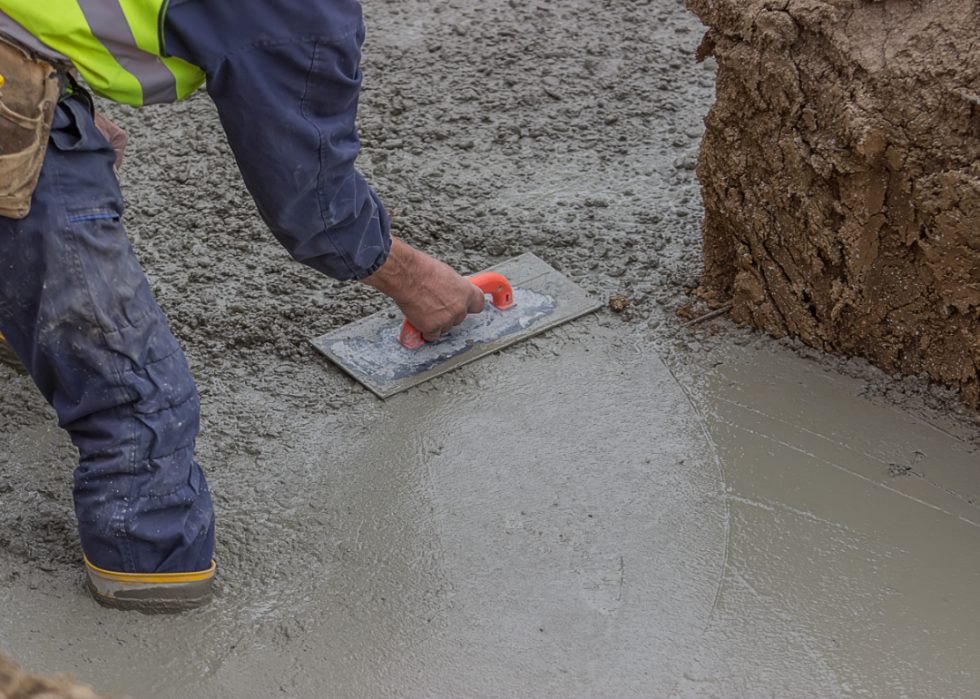
#29. Cement masons and concrete finishers
- Annual mean wage: $48,330
- Employment: 196,120
These specialized masons who work daily with poured and finished concrete must be proficient in setting and leveling procedures. They often work on ground-level projects, including sidewalks, curbs, and roadways, and follow direct instruction and work fast due to the expedited cement and concrete drying times. With time and experience, entry-level masons can become successful concrete finishers.

#28. Excavating and loading machine and dragline operators, surface mining
- Annual mean wage: $48,580
- Employment: 44,090
Also known as backhoe operators, these tradesmen work with heavy-duty buckets, shovels, and scoops to loosen and load earth material. These laborers must have strong depth perception, multi-limb control, manual dexterity, and reaction time. They are also required to maintain certifications needed in some states to operate machinery legally.

#27. Floor layers, except carpet, wood, and hard tiles
- Annual mean wage: $48,610
- Employment: 16,290
Attention to detail and math skills are required to be a floor layer, as these professionals have to follow design specifications and measure and cut around obstructions. Little education is necessary to break into the field, however fitness is a plus since the job entails bending, lifting, and other physical aspects.
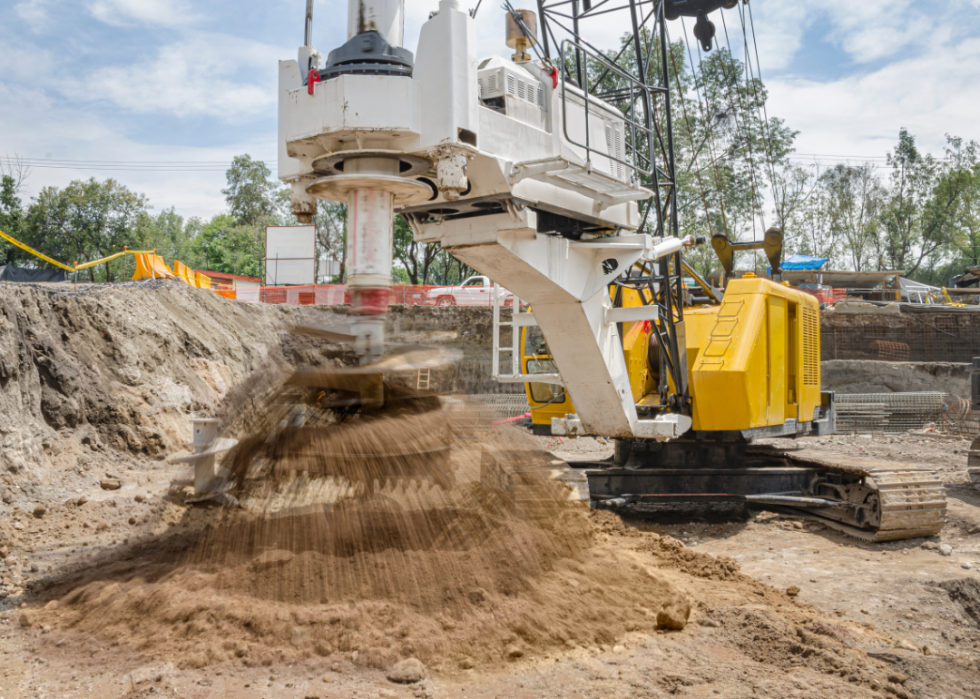
#26. Earth drillers, except oil and gas; and explosives workers, ordnance handling experts, and blasters
- Annual mean wage: $48,890
- Employment: 24,940
Boring into the Earth through the use of a machine, or blasting through with dynamite, falls to Earth drillers and ordnance experts. They are responsible for getting to resources like water or mineral deposits for removal by miners and other laborers. Working with explosives is dangerous work, and while little more than a high school education is required, extensive training may be necessary to work in the field.
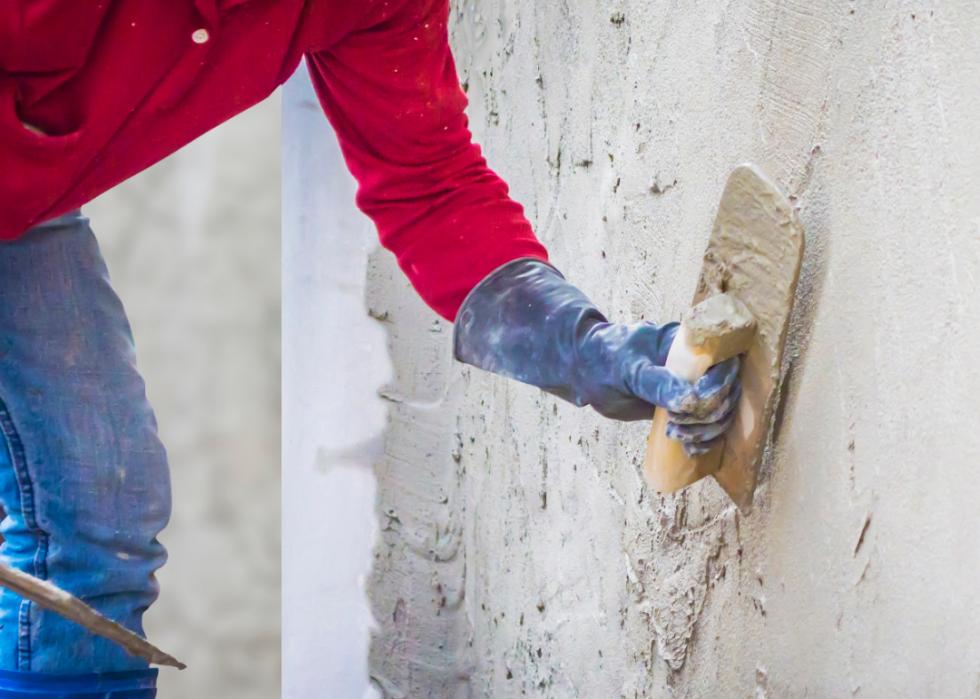
#25. Plasterers and stucco masons
- Annual mean wage: $49,710
- Employment: 27,360
Putting the finishing touches on houses and buildings falls on plasterers and stucco masons. The job entails cleaning surfaces to prepare for the application of stucco or decorative plasters to the interior or exterior of a building, and has no educational requirements. Little training is also necessary to make nearly $50,000 as a plaster or stucco mason.

#24. Glaziers
- Annual mean wage: $49,810
- Employment: 52,400
Cutting, shaping, and installing glass in windows, skylights, or display surfaces fall under the eye of a glazier. People skills and attention to detail are a must for a good glazier, who execute specifications given to them by a customer.

#23. Drywall and ceiling tile installers
- Annual mean wage: $50,560
- Employment: 102,850
Drywall and ceiling tile installers work on the insides of buildings, measuring and cutting materials to finish walls and ceilings. These professionals cut holes in drywall or ceiling tiles to accommodate light fixtures, air vents, or electrical outlets. Physical strength and attention to detail are important for a successful installer.

#22. Service unit operators, oil and gas
- Annual mean wage: $51,390
- Employment: 51,760
Service unit operators in the oil and gas industry ensure that their valuable materials keep flowing through the pipes. They will clear obstructions in lines, and remove broken piping when required, moving rigs or derricks as necessary to make sure they’re level and operating properly. On-the-job training, or an apprenticeship may be necessary to biome a service unit operator.

#21. Carpenters
- Annual mean wage: $52,850
- Employment: 734,170
Working with wood is right in a carpenter's wheelhouse, as they use screws, nails, and hand tools to repair and fashion wooden structures. Physical fitness is a plus, as the job requires lifting heavy objects, and bending and moving for long periods of time. Little education is required, although to become a master carpenter, an extensive apprenticeship for 2,000 hours is involved.
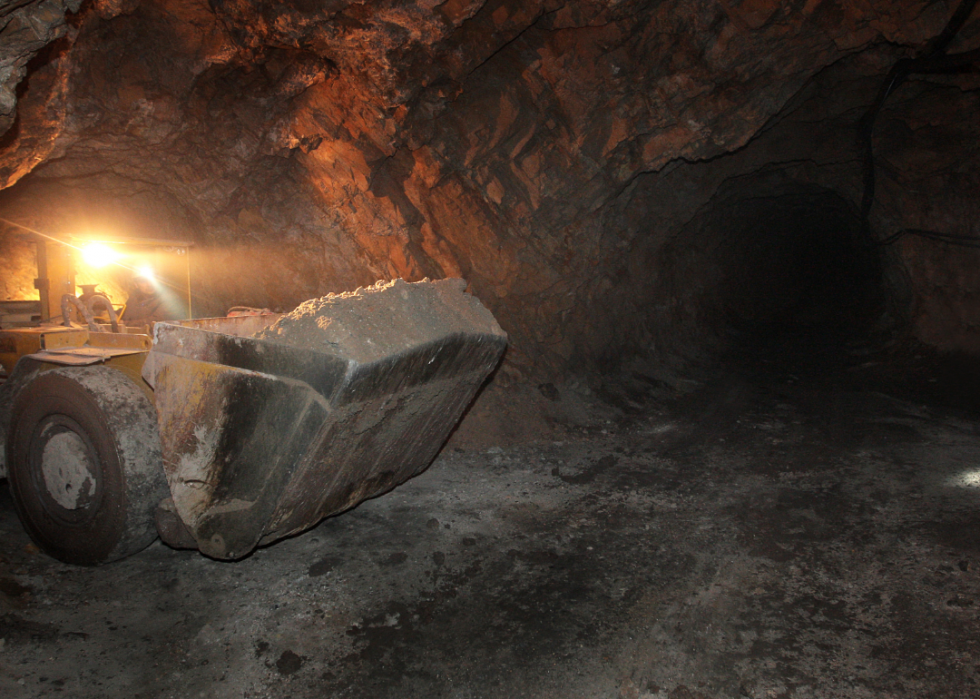
#20. Loading and moving machine operators, underground mining
- Annual mean wage: $53,730
- Employment: 4,200
Gathering materials underneath the Earth’s crust through the use of machines like power shovels or scoops fall to these workers. Machine mining operators follow behind blasts or drillers to scoop loose materials and ready it for transport to the surface. A high school diploma is useful if looking to break into this field.

#19. Insulation workers, mechanical
- Annual mean wage: $54,120
- Employment: 26,670
Insulation workers measure, cut, and install insulation in mechanical systems to ensure temperature control. These workers must be able to calculate the materials needed for a particular job based on a number of environmental and specification requirements.

#18. Operating engineers and other construction equipment operators
- Annual mean wage: $54,210
- Employment: 405,750
Construction equipment operators use a wide variety of machinery on a job site, from bulldozers and front-end loaders, to compressors and pumps. On-the-job training is usually sufficient for an equipment operator to learn the ins and outs of his machine, which is necessary for precise movements. These professionals — of which there are more than 400,000 — average just over $54,000 in earnings.

#17. Sheet metal workers
- Annual mean wage: $54,480
- Employment: 131,300
Sheet metal workers can find themselves in a variety of fields, from heating and cooling to coppersmithing. These professionals design, install, and maintain anything made out of sheet metal, from air conditioning systems to gutters, earning nearly $55,000 in the process. Physical abilities are a must for a sheet metal worker, with the ability to lift heavy items, and move around for long periods of time among the most important skills needed.
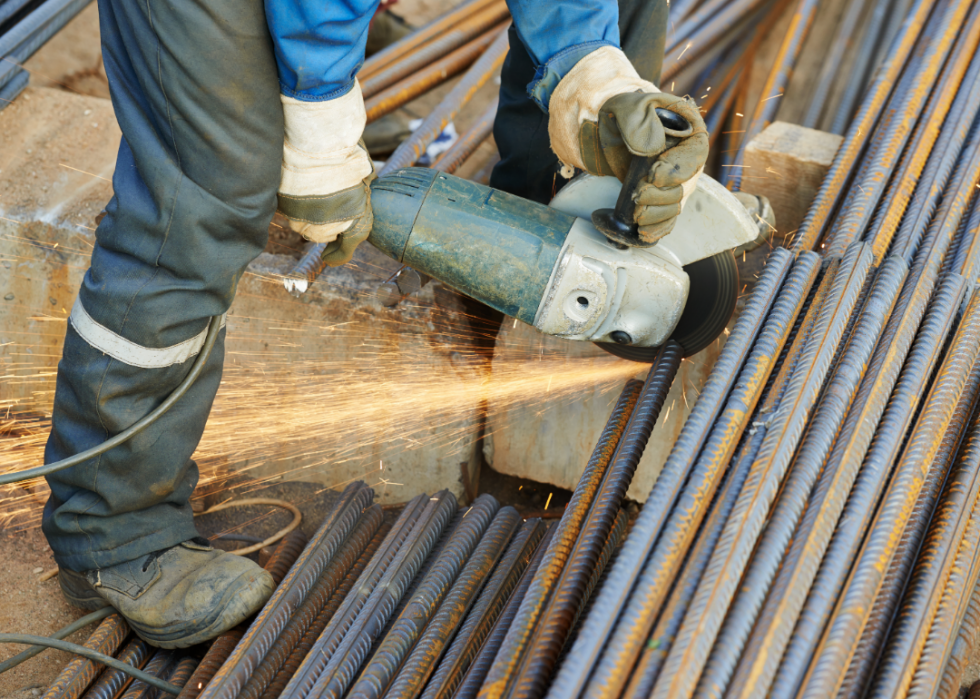
#16. Reinforcing iron and rebar workers
- Annual mean wage: $54,650
- Employment: 18,870
Through the use of iron rods or rebar, these professionals ensure that concrete structures are safe for construction. The ability to measure, cut, and install wire meshing, as well as weld certain pieces together falls under their watch. Reinforcing iron and rebar workers fall just shy of a $55,000 average annual salary, with no degree necessary to break into the field.

#15. Terrazzo workers and finishers
- Annual mean wage: $56,340
- Employment: 2,970
Creating decorative flooring by mixing sand, marble, or coloring to cement or grout falls under the guise of a terrazzo worker. One of the least-employed occupations on the list with less than 3,000 workers, terrazzo finishers sand down rough surfaces to leave a durably decorative facade.

#14. Brickmasons and blockmasons
- Annual mean wage: $56,470
- Employment: 60,650
Brick and block masons use bonding materials to adjoin bricks and blocks to form anything from walls, buildings, or sewers. The ability to lift heavy items and attention to detail in ensuring a level surface are just some of the skills needed to break into the field, which usually requires little more than a high school diploma.
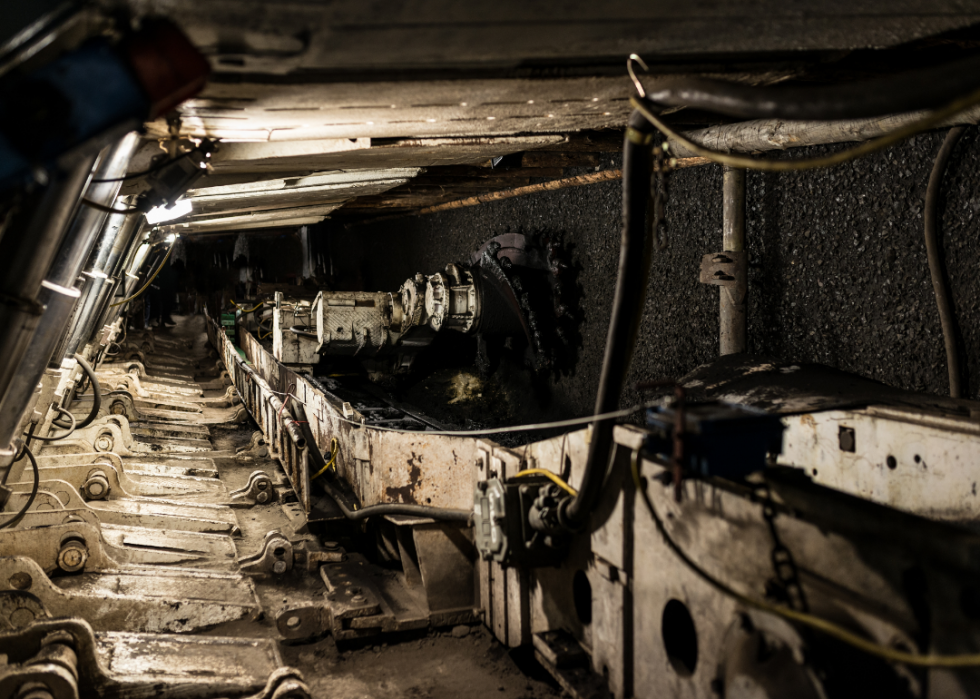
#13. Continuous mining machine operators
- Annual mean wage: $56,530
- Employment: 14,630
Continuous mining machine operators control the processes involved in extracting materials from the Earth’s surface. Keeping self-propelled mining equipment running smoothly and constantly under strict safety standards falls to these professionals. They monitor ventilation within mines, as well as check the stability of mine walls and roofs.
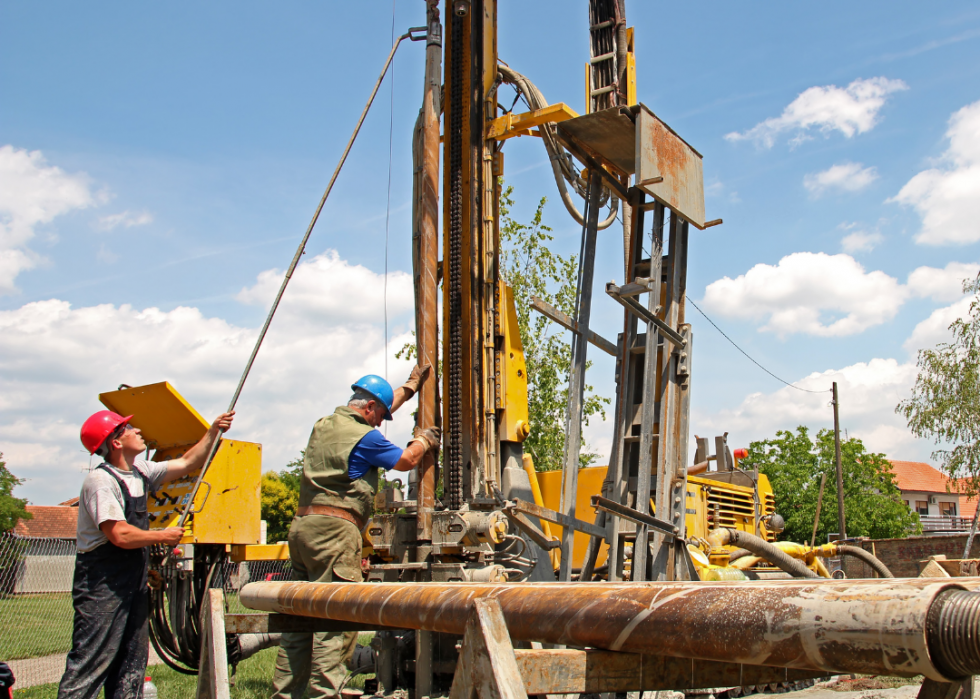
#12. Rotary drill operators, oil and gas
- Annual mean wage: $57,070
- Employment: 21,010
Pulling oil and gas from the depths of the Earth while keeping an eye on gauges and equipment fall under the guise of rotary drill operators. No educational requirements are necessary to break into the drilling process, though experience using tools like powered wrenches is a must for a qualified operator.

#11. Rail-track laying and maintenance equipment operators
- Annual mean wage: $57,160
- Employment: 16,180
Keeping trains running smoothly down the track falls on these professionals, who oversee the installation and repair of train tracks. These workers need the ability to operate machines for ballast cleaning or for the tamping down of future railway tracks. Spotting and fixing problems are essential to this job, which requires a year of on-the-job training and a high school diploma to get started.

#10. Structural iron and steel workers
- Annual mean wage: $59,170
- Employment: 76,570
Structural iron and steel workers put together the country’s buildings by hoisting, positioning, and fastening beams in place. Physical strength, manual dexterity, and the ability to work high above the ground at times are a must for these workers, who can make more than $57,000 on average. No education is required to break into the field, although the ability to read blueprints, weld, or operate machinery may be necessary for advancement.

#9. Roof bolters, mining
- Annual mean wage: $59,560
- Employment: 3,140
Making sure the roof doesn’t cave in while miners remove valuable materials from under the Earth’s surface falls on mining roof bolters. These professionals drill through rock and earth to install supports beams, and position underground jacks to ensure miners’ safety. Roof bolters must pay excellent attention to detail, be able to recognize and troubleshoot problems, and operate equipment needed to get the job done.

#8. Plumbers, pipefitters, and steamfitters
- Annual mean wage: $59,800
- Employment: 442,870
Designing, installing, and repairing pipes and fixtures falls to plumbers, pipefitters, and steamfitters, who earn an average of $60,000 on the job. Steamfitters focus on gases or liquids delivered at high speeds, while plumbers and pipefitters deal in lower flow situations, though all require extensive apprenticeship programs, as well as licensing in some states.

#7. Electricians
- Annual mean wage: $60,370
- Employment: 688,620
Electricians are involved in the design, install, and repair of electrical systems, which can be dangerous work. A high school diploma and 2,000 hours of apprenticeship under an experienced electrician are required to become certified, although many prospective electricians attend a trade school. The need for these professionals is expected to grow faster than other construction fields by 2028.

#6. Tapers
- Annual mean wage: $61,550
- Employment: 17,970
Tapers are the final step before paint goes on the walls, working to seal joints and make surfaces smooth. A high school diploma and on-the-job training are all that's required to undertake a career as a taper, who need the ability to be on their feet for long periods, and repeatedly climb a ladder and reach overhead to tape, sand, and smooth out rough edges.

#5. Construction and building inspectors
- Annual mean wage: $64,390
- Employment: 110,420
Five years experience and a high school diploma is a minimum requirement to break in as a construction or building inspector. These professionals oversee job sites and make sure things are built to a specific code, and that safety protocols are followed. The ability to climb a ladder and fit in crawl spaces is a must for a construction inspector, which are mostly employed by local governments.

#4. Boilermakers
- Annual mean wage: $65,040
- Employment: 15,820
Boilermakers are involved in every part of the boiler process, including the building, repair, maintenance, and cleaning. Good eyesight and finger dexterity are pertinent skills in the boilermaker process, due to the small, intricate parts associated with the process. An associate’s degree can be required, along with an apprenticeship under an experienced boilermaker.
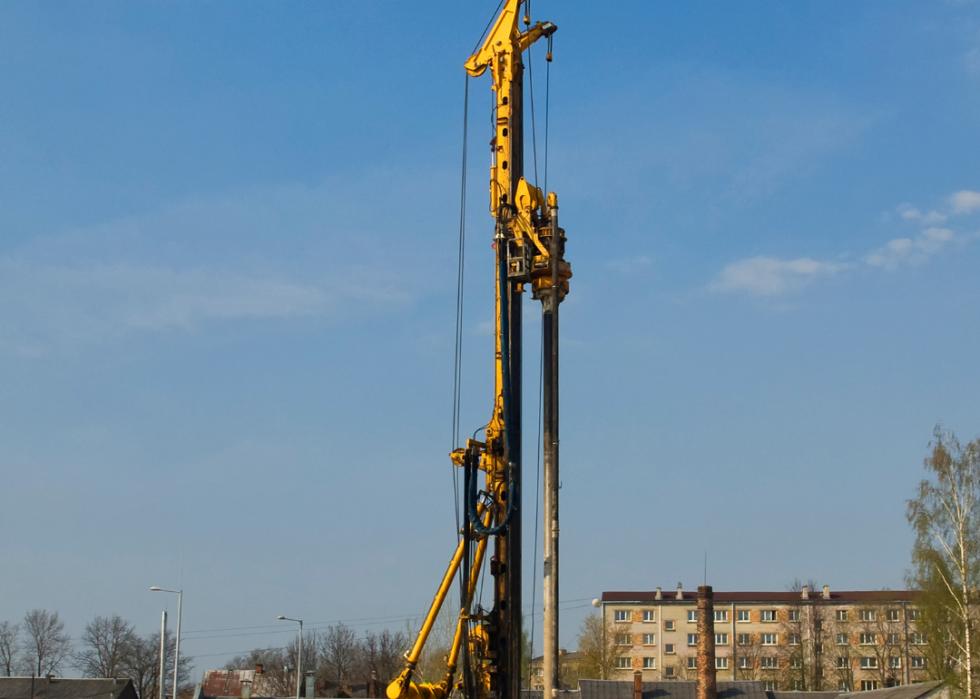
#3. Pile driver operators
- Annual mean wage: $70,230
- Employment: 3,540
Pile driver operators set the foundations for bridges, retaining walls, and piers, among other things, by manning cranes, hammers, and hydraulic presses. A high school diploma and on-the-job training are all that’s required to earn more than $70,000 as a pile-drive operator.

#2. First-line supervisors of construction trades and extraction workers
- Annual mean wage: $71,440
- Employment: 626,180
Major construction projects, and taking valuable materials—such as coal or iron ore—from the Earth, requires planning and manpower. Keeping an eye on the helpers and other tradespersons and ensuring that a job runs smoothly falls on these first-line supervisors. A bachelor’s degree is usually a minimum, as well as extensive knowledge of the job at hand.

#1. Elevator and escalator installers and repairers
- Annual mean wage: $83,250
- Employment: 28,350
An elevator or escalator technician may not necessarily need a formal education to make nearly $100,000 annually, according to the BLS, but the tradesmen do require a license, long-term apprenticeship program, and proficiency in math, mechanics, and troubleshooting. Elevator and escalator technicians must be comfortable working in small spaces, and find full-time work available in rural and city regions home to many multi-story buildings.



